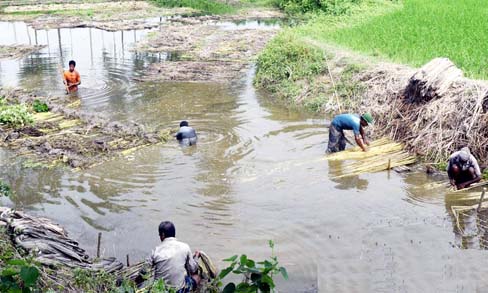RANGPUR, Aug 22, 2019 (BSS) – The farmers are happy getting excellent
market price of newly harvested jute as harvesting of the fibre crop is
nearing completion with better yield rate in all five districts under Rangpur
agriculture region.
Officials of the Department of Agriculture Extension (DAE) said farmers
completed harvesting jute on 45,018 hectares of land producing over 5.16-lakh
bales of jute with an average yield rate of 11.47 bales per hectare by
Wednesday.
The farmers have cultivated jute on 49,792 hectares of land this season
when the recent floods damaged standing jute crop on 4,618 hectares of land
causing production loss of 50,630 bales of the fibre crop worth Taka 24.02
crore in the region.
“Earlier, the DAE had fixed a target of producing over 6.77-lakh bales of
jute fibre from 58,250 hectares of land for the region this season,” said
Horticulture Specialist of DAE at its regional office Agriculturist Khondker
Md. Mesbahul Islam.
However, farmers had finally cultivated the crop on 49,792 hectares of
land, less by 8,458 hectares of land or 14.52 percent than the fixed farming
target, this season in the region.
“After damages caused by floods, standing jute crop on 45,174 hectares of
land remained unhurt for harvesting in Rangpur, Kurigram, Gaibandha,
Nilphamari and Lalmonirhat districts of the region this season,’ Islam said.
The farmers already completed harvesting ‘Tosha’ variety of jute on 40,795
hectares of land to produce 4.754-lakh bales of the fibre crop and local
variety on 6,089 hectares to produce 33,556 bales of jute by Wednesday.
“Besides, they harvested ‘Mechta’ variety of jute on 186 heaters to produce
1,486 bales and Kenaf variety of jute on 510 hectares to produce 6,464 bales
of the fibre in the region,’ Islam added.
District Marketing Officer for Rangpur Agriculturist ASM Hassan Sarwar said
farmers are selling newly produced jute fibre at rates between Taka 1,600 and
Taka 1,800 per mound (40-kg) depending on the varieties and quality of the
fibre.
Deputy Director of the DAE at its regional office Md. Moniruzzaman said
the fixed jute farming target could not be achieved following cultivation of
Aus rice and maize on more land area, shortage of locally produced quality
jute seed and other reasons.
To make jute farming program successful, the DAE, Bangladesh Agriculture
Development Corporation, other agriculture related departments and
organisations extended necessary assistance to farmers.
“However, the fixed production of jute would not be achieved this season
in the region due to little shortfall in farming target and damages caused by
recent floods to standing jute crop despite excellent yield rate of the fibre
crop,” Moniruzzaman added.
Additional Director of the DAE for Rangpur region Muhammad Ali said the
government has taken pragmatic steps to popularise jute cultivation and
ensure fair price to revive past glory of the fibre.
“Jute farming has got a newer dimension in last couple of years after the
government declared the eco-friendly fibre crop as the national agricultural
product and made use of jute sacs mandatory in various sectors,” Ali added.



